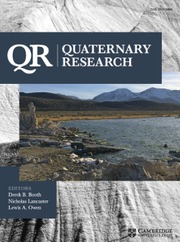Crossref Citations
This article has been cited by the following publications. This list is generated based on data provided by
Crossref.
Xu, Zhiwei
Stevens, Thomas
Yi, Shuangwen
Mason, Joseph A.
and
Lu, Huayu
2018.
Seesaw pattern in dust accumulation on the Chinese Loess Plateau forced by late glacial shifts in the East Asian monsoon.
Geology,
Vol. 46,
Issue. 10,
p.
871.
Li, Yue
Song, Yougui
Fitzsimmons, Kathryn E.
Chen, Xiuling
Wang, Qiansuo
Sun, Huanyu
and
Zhang, Zhiping
2018.
New evidence for the provenance and formation of loess deposits in the Ili River Basin, Arid Central Asia.
Aeolian Research,
Vol. 35,
Issue. ,
p.
1.
Waroszewski, Jaroslaw
Sprafke, Tobias
Kabała, Cezary
Kobierski, Mirosław
Kierczak, Jakub
Musztyfaga, Elżbieta
Loba, Aleksandra
Mazurek, Ryszard
and
Łabaz, Beata
2019.
Tracking textural, mineralogical and geochemical signatures in soils developed from basalt-derived materials covered with loess sediments (SW Poland).
Geoderma,
Vol. 337,
Issue. ,
p.
983.
Mason*, Joseph A.
Jacobs, Peter M.
and
Leigh, David S.
2019.
The Physical Geography and Geology of the Driftless Area: The Career and Contributions of James C. Knox.
p.
61.
Obreht, Igor
Zeeden, Christian
Hambach, Ulrich
Veres, Daniel
Marković, Slobodan B.
and
Lehmkuhl, Frank
2019.
A critical reevaluation of palaeoclimate proxy records from loess in the Carpathian Basin.
Earth-Science Reviews,
Vol. 190,
Issue. ,
p.
498.
Demay, Laëtitia
Obadă, Teodor
Péan, Stéphane
and
Prepeliţă, A.
2019.
Utilization of mammoth resources and occupation of the Dniester-Prut basin territory: The Upper Palaeolithic site of Valea Morilor (Republic of Moldova).
Quaternary Science Reviews,
Vol. 222,
Issue. ,
p.
105898.
Svirčev, Zorica
Dulić, Tamara
Obreht, Igor
Codd, Geoffrey A.
Lehmkuhl, Frank
Marković, Slobodan B.
Hambach, Ulrich
and
Meriluoto, Jussi
2019.
Cyanobacteria and loess—an underestimated interaction.
Plant and Soil,
Vol. 439,
Issue. 1-2,
p.
293.
Wolf, Daniel
Ryborz, Karoline
Kolb, Thomas
Calvo Zapata, Ruben
Sanchez Vizcaino, Jesús
Zöller, Ludwig
Faust, Dominik
and
Lancaster, Nick
2019.
Origins and genesis of loess deposits in central Spain, as indicated by heavy mineral compositions and grain‐size variability.
Sedimentology,
Vol. 66,
Issue. 3,
p.
1139.
Li, Yue
Song, Yougui
Kaskaoutis, Dimitris G.
Chen, Xiuling
Mamadjanov, Yunus
and
Tan, Liangcheng
2019.
Atmospheric dust dynamics in southern Central Asia: Implications for buildup of Tajikistan loess sediments.
Atmospheric Research,
Vol. 229,
Issue. ,
p.
74.
Chen, Jie
Yang, Taibao
Qiang, Mingrui
Matishov, G.G.
Velichko, A.A.
Zeng, Biao
Xu, Min
and
Shi, Peihong
2020.
Interpretation of sedimentary subpopulations extracted from grain size distributions in loess deposits at the Sea of Azov, Russia.
Aeolian Research,
Vol. 45,
Issue. ,
p.
100597.
Dar, Reyaz A.
and
Zeeden, Christian
2020.
Loess-Palaeosol Sequences in the Kashmir Valley, NW Himalayas: A Review.
Frontiers in Earth Science,
Vol. 8,
Issue. ,
Tecsa, Viorica
Gerasimenko, Natalia
Veres, Daniel
Hambach, Ulrich
Lehmkuhl, Frank
Schulte, Philipp
and
Timar-Gabor, Alida
2020.
Revisiting the chronostratigraphy of Late Pleistocene loess-paleosol sequences in southwestern Ukraine: OSL dating of Kurortne section.
Quaternary International,
Vol. 542,
Issue. ,
p.
65.
Börker, Janine
Hartmann, Jens
Amann, Thorben
Romero‐Mujalli, Gibran
Moosdorf, Nils
and
Jenkins, Chris
2020.
Chemical Weathering of Loess and Its Contribution to Global Alkalinity Fluxes to the Coastal Zone During the Last Glacial Maximum, Mid‐Holocene, and Present.
Geochemistry, Geophysics, Geosystems,
Vol. 21,
Issue. 7,
Lancaster, Nicholas
2020.
On the formation of desert loess.
Quaternary Research,
Vol. 96,
Issue. ,
p.
105.
Jiang, Qida
Hao, Qingzhen
Peng, Shuzhen
and
Qiao, Yansong
2020.
Grain-size evidence for the transport pathway of the Xiashu loess in northern subtropical China and its linkage with fluvial systems.
Aeolian Research,
Vol. 46,
Issue. ,
p.
100613.
Li, Yue
Song, Yougui
Fitzsimmons, Kathryn E.
Chen, Xiuling
Prud'homme, Charlotte
and
Zong, Xiulan
2020.
Origin of loess deposits in the North Tian Shan piedmont, Central Asia.
Palaeogeography, Palaeoclimatology, Palaeoecology,
Vol. 559,
Issue. ,
p.
109972.
Loba, Aleksandra
Sykuła, Marcin
Kierczak, Jakub
Łabaz, Beata
Bogacz, Adam
and
Waroszewski, Jarosław
2020.
In situ weathering of rocks or aeolian silt deposition: key parameters for verifying parent material and pedogenesis in the Opawskie Mountains—a case study from SW Poland.
Journal of Soils and Sediments,
Vol. 20,
Issue. 1,
p.
435.
Richter, Christiane
Wolf, Daniel
Walther, Frank
Meng, Stefan
Sahakyan, Lilit
Hovakimyan, Hayk
Wolpert, Tilmann
Fuchs, Markus
and
Faust, Dominik
2020.
New insights into Southern Caucasian glacial–interglacial climate conditions inferred from Quaternary gastropod fauna.
Journal of Quaternary Science,
Vol. 35,
Issue. 5,
p.
634.
Sycheva, Svetlana
Frechen, Manfred
Terhorst, Birgit
Sedov, Sergey
and
Khokhlova, Olga
2020.
Pedostratigraphy and chronology of the Late Pleistocene for the extra glacial area in the Central Russian Upland (reference section Aleksandrov quarry).
CATENA,
Vol. 194,
Issue. ,
p.
104689.
Schaetzl, Randall J.
Baish, Christopher
Colgan, Patrick M.
Knauff, Jarrod
Bilintoh, Thomas
Wanyama, Dan
Church, Michelle
McKeehan, Kevin
Fulton, Albert
and
Arbogast, Alan F.
2020.
A sediment-mixing process model of till genesis, using texture and clay mineralogy data from Saginaw lobe (Michigan, USA) tills.
Quaternary Research,
Vol. 94,
Issue. ,
p.
174.

